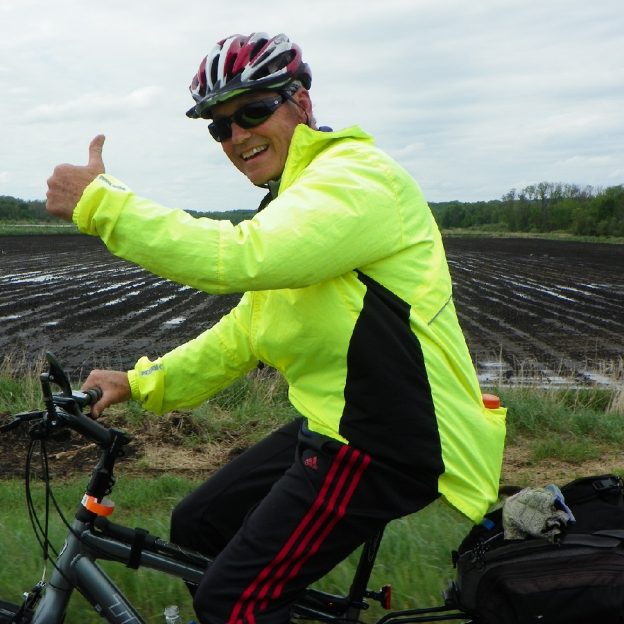by John Brown
With spring approaching, staying dry is the most critical and challenging part of biking or hiking in the rain and snow. The best way to keep warm and dry is to wear waterproof clothing. While most synthetic fabrics still insulate when wet, being damp diminishes their ability to keep you warm. Therefore, a waterproof jacket and pants are a great way to start, but waterproof socks and gloves complete the outfit.
While many materials are naturally waterproof, once perforated with stitching, zipped closed with generic zippers, and left to be loose at all the cuffs, their waterproofing goes out the window. Before you go out and buy anything labeled “waterproof,” read on to understand that all waterproofing is not the same.
Waterproof Clothing and Gear for Staying Dry
To keep water out, look for waterproof clothes with sealed or welded seams (see image). Also, look for waterproof zippers (pictured) or large flaps that prevent water from driving through the zipper. Make sure all the cuffs are adjustable enough to be snuggled tight against your skin.

A waterproof garment is measured in mm of fluid. For example, a fabric that was 5,000 mm waterproof is tested as follows. The fabric is placed over the end of a long tube. Following that, the tube is filled with 5,000 mm of water, and the fabric needs to support the pressure without leaking. Take a look at the table below for a quick reference.
| Rating | Resistance | Weather Conditions |
| 0 mm – 1,500 mm | Water-resistant/snowproof | Dry conditions or very light rain |
| 1,500 mm – 5,000 mm | Waterproof | Light to average rain |
| 5,000 mm – 10,000 mm | Very Waterproof | Moderate to heavy rain |
| 10,000 mm- 20,000 mm | Highly Waterproof | Heavy rain |
Breathe Sweat Out
In addition to measuring waterproofness, textiles are also measured for their ability to breathe water vapor out. Breathable means that the body’s water vapor (sweat) can escape through the fabric. Breathable fabrics work because water vapor is smaller than water droplets. To breathe, the material will be perforated with holes small enough to stop water droplets from getting in but large enough to allow water vapor to escape.
Breathability is important because, as far as insulation is concerned, it’s just as uncomfortable to get soaked in sweat as in the rain. Therefore, using a breathable material with base layers to pull moisture off your skin is a surefire way to stay dry and warm.
Breathability is expressed in how many grams (g) of water vapor can pass through a square meter (m2) of the fabric from the inside to the outside in 24 hours. To that effect, the larger the number, the more breathable the fabric. For example, in a coat with 5,000 gsm breathability, 5,000 grams of water pass through a square meter of the fabric.
Waterproof even when it isn’t raining
During the spring thaw, snow melts during the day and freezes again at night. During my commutes, I wear waterproof clothing to keep warm during the thaw. The rivers of salty water I end up riding through would soak any non-waterproof clothing, rendering it useless.
When Waterproof is Not Important
As the temperature rises, waterproofing becomes less and less critical. It’s less important because, at a specific temperature, waterproof materials cannot breathe enough to keep you dry. Therefore, if it rains hard enough and it’s warm enough, you will get wet.
Be sure to have your waterproof gear ready in the spring and fall. The cool temps and wet conditions can be very dangerous if you aren’t prepared. Being dry is the #1 way to maintain comfort and safety while riding in inclement conditions.
About John Brown, the author
John operates Browns Bicycle in Richfield, MN as a lifelong cyclist and consummate tinkerer. It all started for him in grade school when the bike bug bit, and that particular fever was still there. Now, and over the past thirty years, he has worked at every level in the bike industry. Starting, like most, sweeping floors and learning anything he could about bikes. He eventually graduated as a service manager and then to a store manager. Through the years, he has spent extensive time designing and sourcing bicycles and parts for some of the largest bike companies in the world. All the while focusing on helping as many people as possible enjoy the love of riding a bike. In that pursuit, he has taught classes (both scheduled and impromptu) on all things bikes. John also believes in helping every rider attain their optimal fit on the bike of their dreams. Please feel free to stop in any time and talk about bikes, fit, parts, or just share your latest ride. You can also see more of John’s tricks and tips on the Brown Bicycle Facebook Page.


